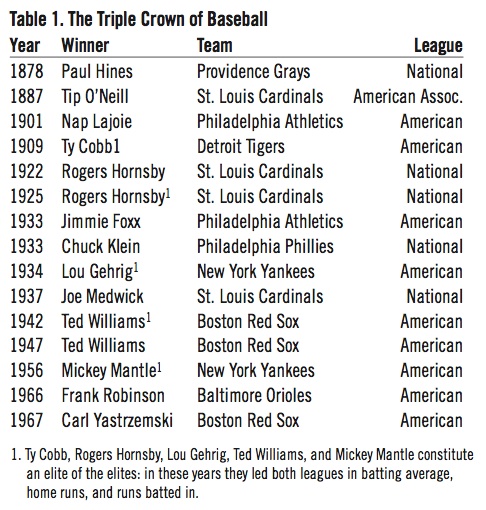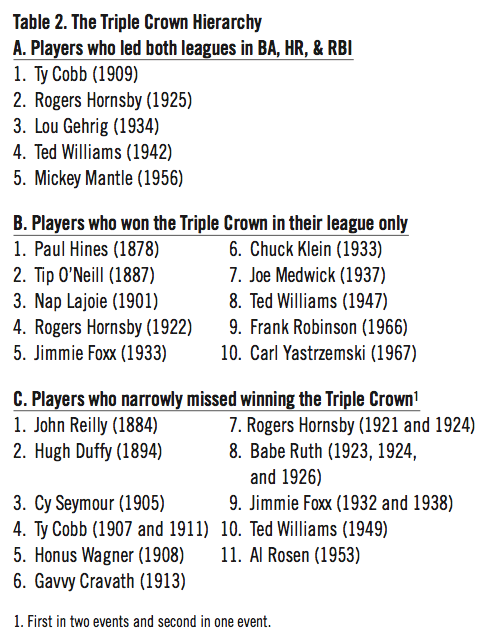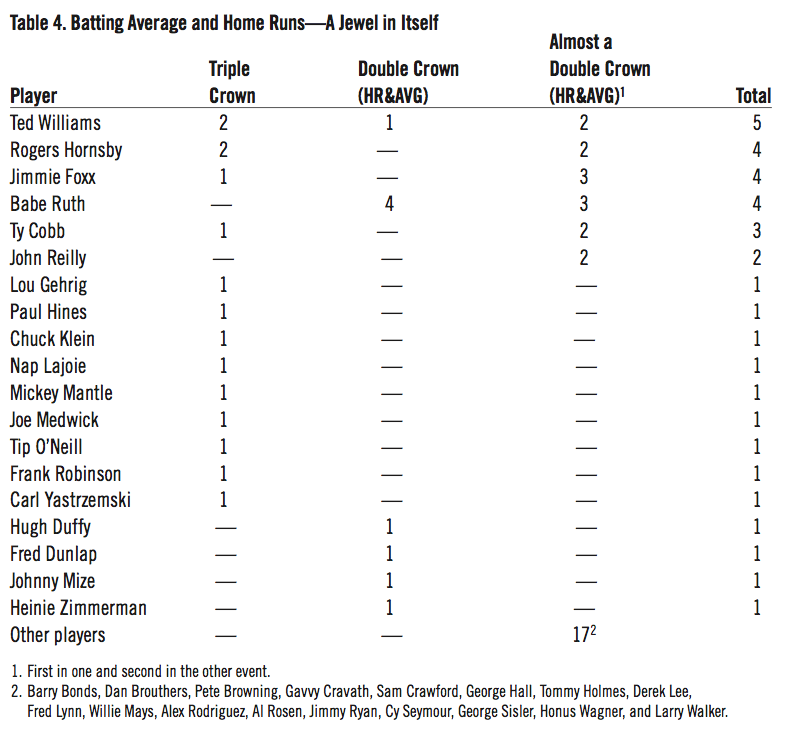Whatever Happened to the Triple Crown?
This article was written by Frederick E. Taylor
This article was published in Spring 2012 Baseball Research Journal
Editor’s note: This is an excerpt from the following book.

The Runmakers: A New Way to Rate Baseball Players
by Frederick E. Taylor
Johns Hopkins University Press (2011)
272 pages
“Hitting a baseball is the single most difficult thing to do in sport. . . . A hitter . . . is expected to hit a round ball with a round bat and adjust his swing in a split second to 100-mile-per-hour fastballs, backbreaking curveballs, and, occasionally, knuckleballs that mimic the flight patterns of nearsighted moths. . . . Even the vaunted major leaguer who hits at the magic .300 level . . . fails seven times every ten at bats.” — Ted Williams, Ted Williams’ Hit List
It has been 43 years since any baseball player has won the Triple Crown of baseball (leading the league in batting average, home runs, and runs batted in). Carl Yastrzemski, of the 1967 “Impossible Dream” Boston Red Sox, was the last player to win the Triple Crown. It was the ninth time it had been done in the previous 41 years, for an average of about once every four and a half years. The times have changed, and the Triple Crown now seems like another impossible dream. (Editor’s note: Miguel Cabrera of the Detroit Tigers won the Triple Crown just months after this article was published in 2012.)
(Click image to enlarge)
Table 1 lists the players who have won the Triple Crown of baseball, and Table 2 expands this list into a Triple Crown hierarchy. It has always been difficult to win the Triple Crown. In the entire 134-year history of the National League, it has been done only five times for an average of once every 26.8 years. It hasn’t been quite as difficult in the American League, as it has been accomplished nine times in 109 years for an average of once every 12.1 years. Some of the greatest players of all time never won a Triple Crown, Babe Ruth, Hank Aaron, Willie Mays, Joe DiMaggio, and Barry Bonds, to name just a few. Rogers Hornsby and Ted Williams were the only two players to win two Triple Crowns. Only once, in 1933, was the Triple Crown won in both leagues in the same year: Jimmie Foxx in the American League and Chuck Klein in the National League. It was a truly unique happening, as they both played for teams from the same city: Foxx played for the Philadelphia Athletics, and Klein played for the Philadelphia Phillies. Ty Cobb was the youngest player to win the Triple Crown (a few months shy of his 23rd birthday), and Lou Gehrig was the oldest (three months after his 31st birthday).
Why is it so difficult to win the Triple Crown? And why has it seemed almost impossible in recent years? The answer to the first question is no great secret. Almost anyone who has played baseball knows the answer. Just hitting a baseball is difficult enough, as Ted Williams so articulately explained above. To win the Triple Crown of baseball, you have to combine hitting for strength (home runs) with hitting with skill (batting average) and do it in a timely fashion, that is, with runners on base (runs batted in). Triple Crown hitting is three times as difficult as ordinary hitting. It takes three very special talents to win the Triple Crown. You also have to have a little luck because runs batted in are from the bases and you therefore have to have teammates on base when you come to bat.
(Click image to enlarge)
The answer to the second question is found partly in the nature of our times. This is an age of specialization, and baseball is no different from other activities. Baseball players emphasize either the home run or the batting average, but not both. Power hitting has become the name of the game. Twenty-six of the 50 all-time leaders in career home run percentage (with 1,000 or more games) are playing or played during the current Live Ball Enhanced Era, and eight of them ranked in the top 13 (Barry Bonds, Jim Thome, Adam Dunn, Alex Rodriguez, Albert Pujols, Sammy Sosa, Juan Gonzalez, and Manny Ramirez). Only 4 of the 50 all-time leaders in batting average (with 1,000 or more games) are playing in the current Live Ball Enhanced era (Albert Pujols, Ichiro Suzuki, Todd Helton, and Vladimir Guerrero), and none of them ranks in the top 10. Albert Pujols and Vladimir Guerrero are the only players active in the current Live Ball Enhanced Era who rank in the top 50 in both home run percentage and batting average.
Perhaps the biggest factor working against winning the Triple Crown is the expansion over a number of seasons from 8 to 14 teams in the American League and from 8 to 16 teams in the National League. The more competition there is, the more difficult it is for one player to lead the league in all three events, but it does not make it impossible. Frank Robinson and Carl Yastrzemski won the Triple Crown in a 10-team American League. Larry Walker (1997) and Barry Bonds (2002) narrowly missed leading the National League (with 14 teams in 1997 and 16 teams in 2002) in batting average and home runs, the most difficult of the Triple Crown events to win simultaneously, and almost as difficult as winning the Triple Crown itself. Possibly the most hopeful observation of all is that five Triple Crown winners led both leagues (16 teams at that time) in all three events.
(Click image to enlarge)
Table 3 lists the players who have won the so-called “Double Crown” of baseball, that is, players who have won two legs of the Triple Crown but not the third leg. The Double Crown has been won 123 times: 92 in home runs and runs batted in, 25 in runs batted in and batting average, but only 6 times in batting average and home runs. Thus, the most difficult Double Crown combination is batting average and home runs. In the 134 National League and 109 American League seasons, a player has led his league in batting average and home runs only 19 times (14 Triple Crowns and 5 Double Crowns), for an average of once every 16.8 years in the National League and once every 9.9 years in the American League. One Triple Crown was won by an American Association player (Tip O’Neill), and one Double Crown was won by a Union Association player (Fred Dunlap). Both of these leagues were regarded as major leagues at that time.
The players who have won the Triple Crown and those who have won or have come close to winning the Double Crown in batting average and home runs are listed in table 4. Ted Williams was the only player in the entire history of major league baseball to lead his league in batting average and home runs 3 times (two Triple Crowns and one Double Crown), and he narrowly missed two other times in 1949 (when he missed a third Triple Crown because he lost the batting title to George Kell .3428 to .3429) and in 1957. Rogers Hornsby led his league in batting average and home runs twice (by virtue of his two Triple Crowns), and 15 other players did it once. It hasn’t been done in the National League since 1939 ( Johnny Mize) and in the American League since 1967 (Carl Yastrzemski).
It is interesting to look at the winners of the Triple Crown in relation to the positions they played. The position that has produced the most Triple Crowns is left field (five): Ted Williams (two), Joe Medwick, Tip O’Neill, and Carl Yastrzemski. Three center fielders (Ty Cobb, Paul Hines, and Mickey Mantle) and two right fielders (Chuck Klein and Frank Robinson) also won the Triple Crown. The infield has produced five Triple Crowns: Rogers Hornsby (two) and Nap Lajoie at second base, and Jimmie Foxx and Lou Gehrig at first base. No shortstop, third baseman, or catcher has ever won a Triple Crown.
(Click image to enlarge)
It is also interesting to look at the teams that the winners of the Triple Crown played for. The St. Louis Cardinals had the most Triple Crown winners (Rogers Hornsby twice, Tip O’Neill, and Joe Medwick). The Boston Red Sox were second (Ted Williams twice and Carl Yastrzemski). The Philadelphia Athletics had two (Nap Lajoie and Jimmie Foxx), as did the New York Yankees (Lou Gehrig and Mickey Mantle). Four other teams had one each, the Philadelphia Phillies, the Detroit Tigers, the Baltimore Orioles, and the Providence Grays.
All except three Triple Crown winners were elected to the Baseball Hall of Fame. Fred Dunlap, Paul Hines, and Tip O’Neill played when the home run was rare and therefore not recognized as a major statistic. Paul Hines and Ty Cobb won the Triple Crown with only four and nine home runs, respectively. Only later when the home run became more common and therefore extolled was the Triple Crown recognized as a prize, whereupon Dunlap, Hines, and O’Neill became retroactive winners of the Triple Crown. The fact that John Reilly (a near Triple Crown winner) and O’Neill played most of their careers in the American Association may have been another factor in their being passed over for the Hall of Fame.
The probability of someone winning the Triple Crown in the near future is not great. Among active players, only six have even won a Double Crown: Todd Helton (2000), Alex Rodriguez (2002 and 2007), Andruw Jones (2005), Ryan Howard (2006 and 2008), David Ortiz (2006), and Matt Holliday (2007)?and none of them combined batting average and home runs or led the league in home runs and ranked as high as third in batting average. Someone will win the Triple Crown again sometime. An exceptional player will have an exceptional season, or less emphasis may come to be placed on strength and more on a balance of strength and skill. The talented player who combines strength, skill, and timeliness stands a much better chance for genuine baseball immortality than the one-dimensional power hitter who concentrates solely on hitting home runs.
The Triple Crown performances of the past were truly remarkable. Let’s hope that we will witness such performances in the future. Be on the lookout for the player who has the potential for leading his league in both batting average and home runs. A player with the ability to combine hitting for accuracy with hitting for power will inevitably have a lot of runs batted in. Maybe the dream of a Triple Crown winner is not an impossible one after all.
In the meantime, each major league should give an annual Strength, Skill, and Timeliness (SST) Award. Only players ranking in the top five in batting average, home runs, and runs batted in or players ranking first in two of those events would qualify. For each of the three events, the league leader would get five points, the runners-up would get four points, and so on through the top five. The player with the most total points would win the SST Award. If this award had been in effect the past five years, Albert Pujols would have won the award three times and Matt Holliday and Ryan Howard once each (2007 and 2008, respectively) in the National League. Alex Rodriguez would have won the award twice and David Ortiz and Mark Teixeira once each (2006 and 2009, respectively) in the American League. No American League player would have qualified in 2008.
We live in an age of specialization. In the baseball world, batters try to concentrate on getting hits or hitting home runs. Players who do both are rare, and those who do both with runners on base are even rarer. Being able to do more than one of these things is a great talent. Any team would like to have such a player in its batting order. Giving an annual SST Award would be a great way to recognize players who come closest to the Triple Crown ideal.
FREDERICK E. TAYLOR worked for the departments of Commerce and Defense and was a professor at several universities. His interest in baseball began in the 1930s when he saw his first major league game in which Lefty Grove and Jimmie Foxx played for Boston and Connie Mack managed Philadelphia. Dr. Taylor is the author of “The Runmakers: A New Way to Rate Baseball Players,” from which his article in this “Baseball Research Journal” is excerpted, courtesy of The Johns Hopkins University Press. His email address is: ruthfredtaylor@verizon.net.






